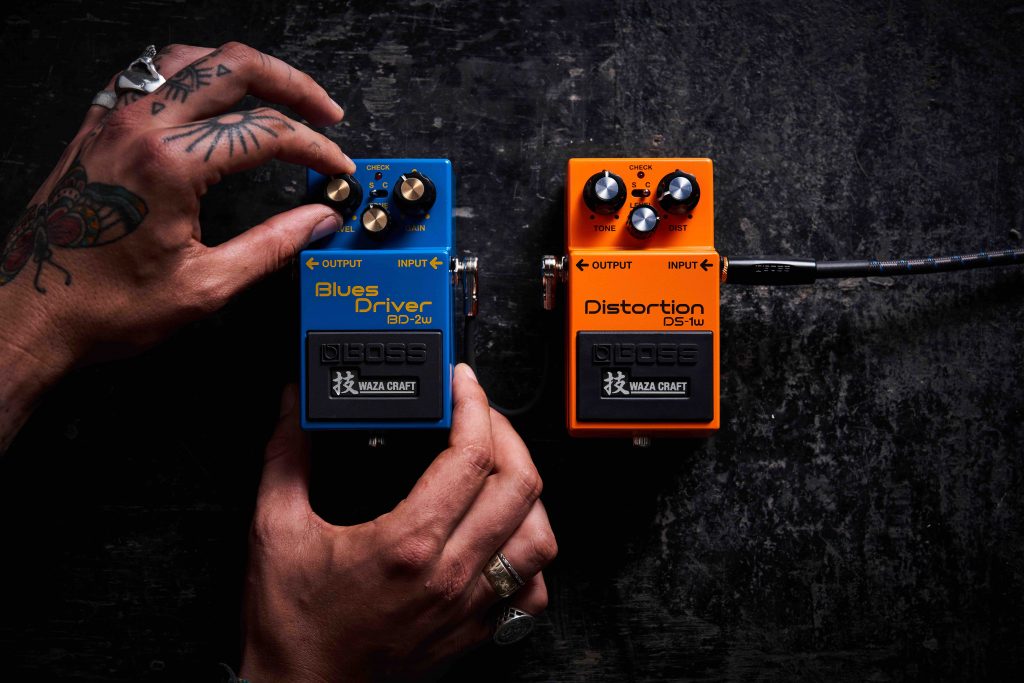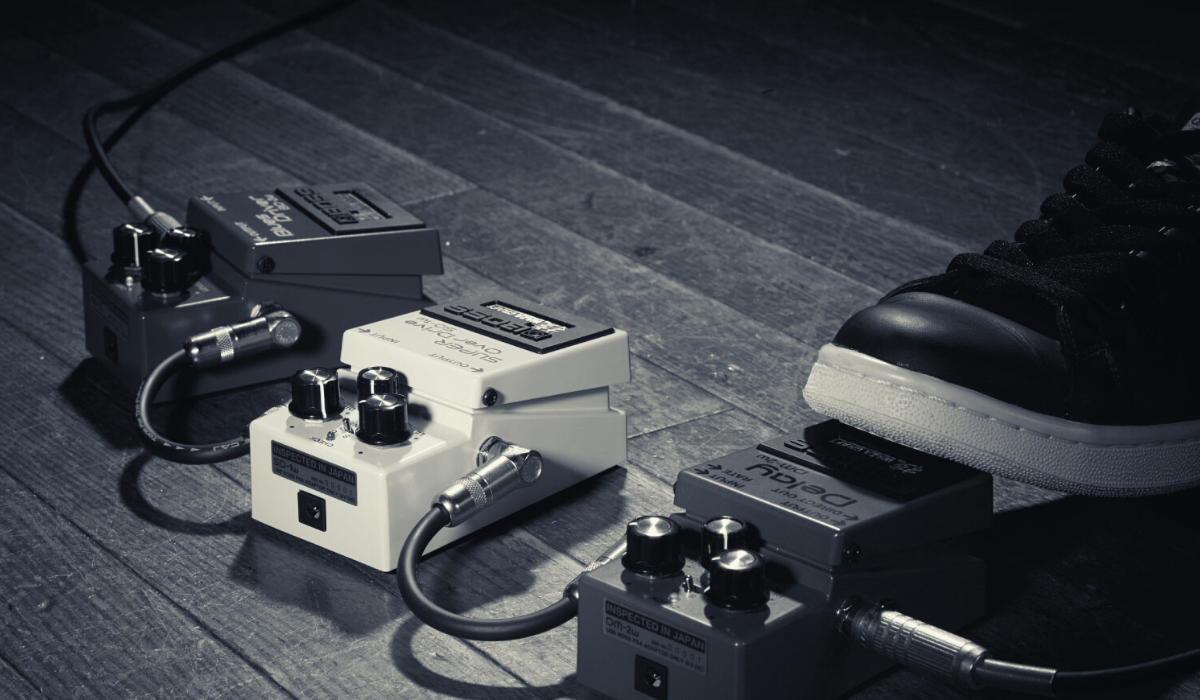Combining pedals is a powerful form of experimentation for guitarists, and overdrive pedals are among the most straightforward to integrate with other effects. When we open up the sonic palette by introducing a new pedal to the mix, it does more than change the sound; it creates new avenues for songwriting, riffs, and possibilities. Learn how different effects interact with overdrive and get useful tips on gain stacking, amplifier setups, and more.
Overdrive
Due to its specific ability to preserve amplifier tone, dynamics, and nuances, overdrive improves and boosts an existing signal, adding subtle gain without coloring a sound. Overdrive works particularly well with other effects, as an overdriven guitar sound will not drown out other pedals.
Guitarists can create exciting sounds and add depth and complexity to playing and songwriting by pairing an overdrive with other pedals. Combining overdrive with other pedals can add saturation to existing effects at any volume without becoming too harsh. Another benefit of overdrive with other pedals, such as delay, reverb, and modulation effects, is creating complex and dynamic sounds.

Pedal Combinations
Distortion and Overdrive (Gain Stacking )
Combining two drive/distortion pedals is often referred to as gain stacking. This option is perfect for guitarists who love the always-on overdrive method but need somewhere to go when the chorus kicks in. It’s a powerful technique for more versatility from distortion and overdrive sounds.
Stacking overdrive and distortion involves using both an activated overdrive pedal and a distortion pedal in the same effects chain. Do this by placing the overdrive pedal before the distortion pedal in the chain or using a multi-effects pedal that simultaneously allows both effects. This creates a powerful, high-gain sound for heavy metal and other genres requiring generous distortion and overdrive dynamics.
Recommended Pairings
- BOSS OD-3 and SD-1
- BOSS SD-1 and BD-2W
"Stacking overdrive and distortion involves using both an activated overdrive pedal and a distortion pedal in the same effects chain."
Compressor and Overdrive
A compressor pedal reduces the volume of the loudest parts of a signal while boosting the quietest. This can help to even out playing and make the sound more consistent. The effect is also useful for bass players, ensuring low-end and high-end are equal in volume. A compressor with overdrive can add more sustain to guitar solos and licks without introducing more gain.
By placing the compressor pedal before the overdrive pedal in an effects chain, players can shape the signal sent to the overdrive pedal. This allows for a more consistent and controlled overdrive sound without unwanted volume peaks and valleys.
Recommended Pairings
- BOSS CS-3 and OD-3
- BOSS CS-3 and BD-2W
Chorus and Overdrive
A sprinkling of chorus complements overdrive perfectly by thickening up a tone or adding sparkle. Generally, chorus pedals sound much better on clean or low to moderately distorted signals. Simply dial back the gain when playing intricate progressions. By utilizing chorus and overdrive, we can reproduce the sounds of classics like “Every Breath You Take” by The Police, Prince’s “Purple Rain,” and “Come As You Are” by Nirvana.
Recommended Pairings
- BOSS CH-1 or CE-2w and BD-2W
- BOSS CH-1 or CE-2w and SD-1
"A sprinkling of chorus complements overdrive perfectly by thickening up a tone or
adding sparkle."
Delay and Overdrive
Combining a delay pedal with a short delay time and a low repeat level with overdrive is a common tactic to fatten up a lead sound. The intro to “Welcome to the Jungle” by Guns N’ Roses is an excellent example. Slash used a BOSS DD-3 Digital Delay set to the max range of 800ms for the song.
Conversely, pairing a delay pedal with extended repeats is a great way to create unique sonic soundscapes. Pairing delay pedals with overdrive is a perfect method for guitarists without an effects loop to make delays as clean as possible without unwanted distortion as repeats oscillate.
Recommended Pairings
- BOSS DD-3T and SD-1
- BOSS DM-2W and BD-2W
"Combining a delay pedal with a short delay time and a low repeat level with overdrive is a common tactic to fatten up a lead sound."
EQ and Overdrive
An EQ pedal cuts or boosts specific frequencies to color and fine-tune an overdriven sound. Many guitar players will add an EQ for mesmerizing results. An equalizer also works as a boost, raising gain and emphasizing overdrive over a specific frequency range.
By pairing EQ with an overdrive and placing it after an overdrive, players can adjust the frequency response of the overdrive to suit personal preferences better. Boost the low end to create a warmer and thicker sound, or cut the high end for a smoother, more transparent tone.
- Option 1: Place EQ before the overdrive to influence the signal’s color.
- Option 2: Place EQ after an overdrive to increase volume for a louder lead sound.
Recommended Pairings
- BOSS GE-7 and SD-1
- BOSS GE-7 and OS-2
Reverb and Overdrive
Reverb can take a dry signal and provide life and ambience. Adding overdrive provides a darker yet natural tone that puts the power back into the sound. On the BOSS RV-6, the Time sets the length of reverberation or decay, while Level controls the intensity. For light reverb, reduce the Level and set a longer Time while reducing the amount of Gain on the overdrive pedal.
The Tone control adds brightness or depth to the sound. Reduce the Tone and add bottom end weight by turning the knob counter-clockwise. If it is too overbearing, increase the Tone and treble by turning the knob clockwise.
"Reverb can take a dry signal and provide life and ambience. Adding overdrive provides a darker yet natural tone that puts the power back into the sound."
Usually, reverb pedals come last in the signal chain as they must be affected by everything before. Placing reverb before overdrive sends a signal with effects to the overdrive. However, some players love this unorthodox application.
Recommended Pairings
- BOSS RV-6 and OD-3
- BOSS RV-6 and BD-2
Amp Setups
Building a Pedalboard Around an Amplifier
It’s not always practical to use a cranked tube amp. Players need something to push the amp into saturation at lower volumes, bringing out the quality of the sound without adding too much color. This approach is building a pedalboard rig around amplifier channels. Indeed, an overdrive pedal can accentuate the qualities of a beloved amplifier.
For example, the BOSS SD-1 works as a subtle overdrive and volume boost simply by turning up the Level and Drive settings. Set the amp at a lower volume using preferred EQ settings, then use the pedal to push it into saturation at lower volumes. Then, a reverb or delay can manipulate settings to improve, rather than replace, the onboard sound.
"Players need something to push the amp into saturation at lower volumes, bringing out the quality of the sound without adding too
much color."

Amplifier as Pedal Platform
Using an amp as a pedal platform is the opposite of the previous scenario. This approach is the purest way to get the sound of an effects pedal aside from an effects loop. Fans of this method will use a very clean amplifier and pedals to get the sound they want, disregarding the amplifier tone. Bands like Metallica and The 1975 are known for using Roland Jazz Chorus amplifiers to get their pristine sound and taking full advantage of effects.
"Bands like Metallica and The 1975 are known for using Roland Jazz Chorus amplifiers to get their pristine sound and taking full advantage of effects."
Modulation Inside Effects Loop
Using an overdrive pedal combined with a delay pedal in the effects loop provides delay clarity without being affected by the preamp. The overdrive pedal adds grit and character to the guitar tone, while the delay pedal creates space and depth. This approach benefits players who want to develop atmospheric or ambient guitar sounds.
Modulation Outside Effects Loop
One benefit of pairing an overdrive pedal outside the effects loop with a delay pedal inside is it allows the player to add gain to their guitar signal without affecting the delay. The overdrive pedal outside the effects loop can also help preserve the delay effect’s character.
"Using an overdrive pedal combined with a delay pedal in the effects loop provides delay clarity without being affected by the preamp."
With Multi Effects Switcher
Some guitar players use multiple pedals, including overdrive, delay, and distortion. The BOSS MS-3 Multi Effects Switcher is a versatile pedal that controls numerous effect pedals. When using the MS-3, players hook up three external pedals and easily switch between different combinations of those pedals. Pairing the MS-3 with an overdrive pedal and other pedals provides greater sonic flexibility and control.
"Pairing the MS-3 with an overdrive pedal and other pedals provides greater sonic flexibility and control."
A World of Sounds
Combining overdrive pedals with other effects provides players countless options while preserving their personal tone. Pairing pedals can be as simple as stacking overdrives for a thicker tone or as complex as chaining multiple pedals for songwriting inspiration. Blend the best characteristics of overdrive pedals with different effects types and create a world of extraordinary sounds.






